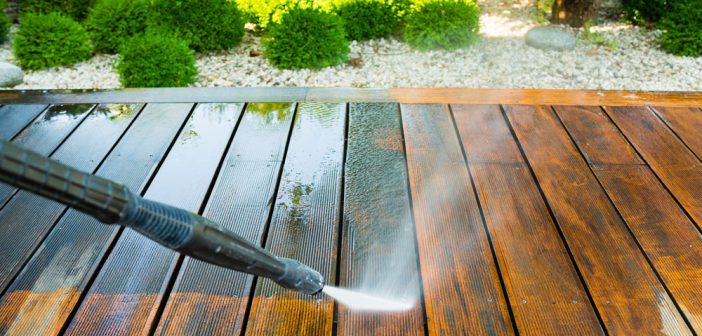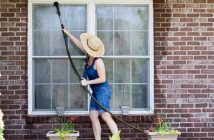Dirt, dust, mildew and other grime quickly make many items around the home and even the exterior of the home itself look dingy and unappealing. Pressure washing can give new life to walls, patios, porches, driveways, sheds, outdoor furniture and much more. Using a pressure washer is very simple, but getting the most out of your machine and cleaning safely with it is a bit more complicated. Here are some useful tips and tricks for pressure washing.
Always Point the Nozzle in a Safe Direction
Pressure washers are much more dangerous than they seem. The water pressure can get so high that it can cut through skin, muscle, damage your eyes and cause other serious injuries. Some pressure washer incidents, particularly ones involving industrial strength pressure washers, have been so severe that they’ve lead to permanent damage and even death.
To help prevent injury, always keep the nozzle pointed in a safe direction. Never point it at yourself, other people or animals. Keep your hand away from the trigger until you’re aimed at the surface you want to spray and no one is in the way.
Prep the Surface Before Cleaning
Your pressure washing job can be made much easier and quicker if you try to clean the area or surface a little before you wash it. For instance, you might want to blow the leaves off of the driveway or give the porch a quick sweeping. The less you need to wash, the better.
Know Your Nozzle Settings
Pressure washers have different settings for their nozzles to increase or lower the pressure. While pressure washers are all different in their nozzle designs and settings, the general rule of thumb for nozzle sizes are 0, 15, 25, 40 and 65 degree angles.
Zero should be used for tight crevices and getting stains off of metal or asphalt. It is not to be used on wood or anything painted as it could damage the wood or peel the paint.
The 15 degree setting is meant for tough general cleaning on almost any surface.
For a lighter and wider spray, useful for clearing dirt and leaves from driveways, walkways and porches, use a 25 degree angle nozzle.
Finally, the 40 to 65 degree angle setting should be used for applying soap and other cleaning fluids.
It’s best to have your nozzle set to 40 or 65 degrees before you turn on your pressure washer to avoid accidentally damage or injury.
Use the Right Cleaning Solution
It’s surprising how many people choose to forego cleaning solutions entirely, believing the water pressure itself is good enough to do the job thoroughly. Cleaning with a pressure washer is much quicker and more effective if you use detergent.
Generic pressure washer detergent is good enough to clean many surfaces, but there are cleaners meant for tougher or more specific cleaning purposes. For example, there are cleaners meant for asphalt, grease stains, vehicles, windows, mildew and much more. Make sure you have the proper cleaner for the job before you start up your pressure washer.
Don’t Leave Cleaning Solution Soaking Too Long
Soaking surfaces before cleaning them is usually a good idea, but if you leave something soaking in cleaning solution until it dries, it will be much less effective. You also might end up leaving a film on the surface or staining it if you leave cleaning solution on it for too long.
Use Your Pressure Washer to Remove Graffiti
If you have a building or vehicle that has been marred with graffiti, you don’t have to spend hours scrubbing it with a brush and harsh chemicals or even repainting the surface to get rid of it. The higher pressure settings on your pressure washer combined with a strong cleaning solution can get nearly any instance of graffiti off of any surface.
Be Safe Around Electricity
Pressure washing around the house makes you susceptible to electrical hazards like light fixtures, cable boxes and power lines. Not only can your pressure washer damage the wires and create a hazard, but you’ll be standing in water for a majority of your time cleaning, which could presents the danger of electrical shock.
Avoid all power lines and try to cover electrical fixtures with hard plastic boxes or block them off with hard plastic sheets.
Clean Your Gutters
When most people think of pressure washing, they think of getting films of dirt and mildew off of surfaces. However, you can also use it for other purposes such as cleaning out your gutters.
Set your pressure washer to a medium setting and use an extension or long hose attachment to direct the water into the gutters. Not only can you blast the dirt, leaves, twigs and other grime from the top gutters, but you can also send the stream down into the drainage pipe to clear any obstructions.
Protect Plants and Gardens
Even one accidental hit from a pressure washer can severely damage plants. The cleaning solution can also be so harsh that it can severely damage or even kill plants. Cover nearby plants and gardens with a tarp or a big wooden box and take potted plants into the house before you start washing anything.
Clean Small Areas at a Time
Many nozzles can provide a wide spray, and it may be tempting to wash big areas at once, but it’s actually much faster to clean a big surface bit by bit. When you clean smaller areas, you’re focusing the water pressure better and making the surface cleaner faster. Standing further back and using wider nozzles makes the pressure lower and makes it more difficult clear the whole surface.









